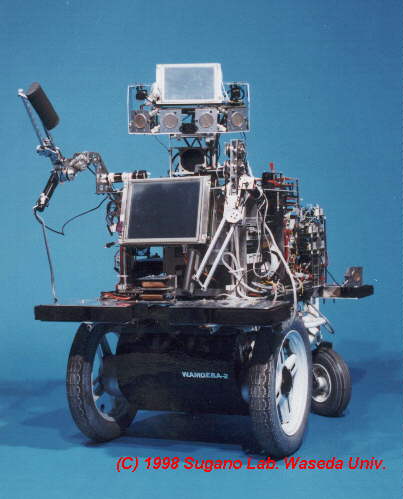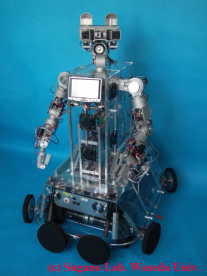WAMOEBA project
-- Do robots have emotions?
We are focusing on artificial emotions based on the robots' own embodiment. In conventional emotion modeling for robots, the emotion models are designed by referring to the research results from the field of psychology. However, those results are based on the researchers' self-observation, so the models are not appropriate for robots.
 Self-preservation function & hormone parameter
Self-preservation function & hormone parameter
We are developing an emotional communication robot, WAMEOBA (Waseda-Ameba, Waseda Artificial Mind On Emotion BAse), to research a robot emotional model, focusing especially on the emotional expression during human-robot interaction (HRI). The emotional expression we are now focusing on is low-level and strongly connected to self-preservation. An example of self-preservation is illustrated by referring to cats; when cats encounter large dogs, they prepare to fight / escape with their fur standing on end.
WAMOEBA-2
To introduce the law of self-preservation into WAMOEBA, we implemented WAMOEBA-2 with the following self-observing sensing systems:
- Battery voltage sensor
- Battery output current sensor
- Circuit temperature sensor
- Motor temperature sensor
We also implemented cooling-fans as a control function for self-regulation as well as DOFs for vehicle maneuvering, arm behavior, camera pan-tilt, and other movements.

Fig.1 WAMOEBA-2
Self preservation function
Each sensor category has its own “self-preservation function” to calculate a “self-preservation value” that indicates how much danger the robot is in (or not). The self-preservation function is a kind of fuzzy membership function. The sensor current value and its derivative value are the inputs. The higher the self-preservation value, the more danger the robot is in.
Let's take a look at the battery voltage as a comprehensive example. If the battery is full, the self-preservation value for battery voltage is very low. If the battery voltage is near the lowest drivable voltage for the robot's controller, the self-preservation value will increase to a very high level. If the battery voltage is higher than the voltage in the fully charged state, the battery would be overcharged, which means the robot was also in danger (self-preservation value is high).
The synthesized self-preservation value is the highest value of all the sensors' self-preservation values. We defined that the synthesized self-preservation value is the robots' own self-preservation value.
Hormone Parameter (Endocrine system)
To realize the expression of emotion, we have defined a “hormone parameter.” (Here, hormone means the endocrine hormone). The hormone parameter is an intermediate parameter vector that is calculated by the absolute value and derivative values of the self-preservation value of the robot.
In WAMOEBA-2's endocrine system, the hormone parameter has four dimensions. The “hormones” are secreted based on the self-preservation values and are decomposed over time. We named the four hormone parameters “R-endorphin,” “R-adrenalin”, “R-noradrenalin,” and “R-dopamine.” The control parameters for the actuators and sensors are regulated according to the amount of the hormone parameters. For example, the pitch of the voice synthesis is higher when the R-endorphin parameter is high.
Emotional Expression of WAMOEBA-2
WAMOEBA-2 can express its own body-based emotion. For example, when the temperature of the motors increases, the mobility is suppressed and the electric current that is saved will be used for the cooling fans. People (observers) will be impressed that the robot seems to get tired and become sweaty.
As a result of this implementation, we show that the body-based, homeostatic motions without the psychological emotion models can portray an emotional expression.
This bottom-up approach to the robots' emotion and intelligence will make robots more “grounded” and is very important for developing more flexible and robust behaviors.
 Adaptive Human Robot Interaction (HRI) with Interactive Evolution
Adaptive Human Robot Interaction (HRI) with Interactive Evolution

Fig.2 WAMOEBA-3
In the WAMOEBA projects, we are investigating the emotional expression based on the robots' own bodily state; however, the parameters for the robots' motions are defined by the designer a priori.
We implemented interactive evolutionary computation (IEC) in the robot to make the robot more adaptive to the surrounding environment that includes human beings. IEC is a kind of machine learning algorithm categorized as an evolutionary strategy. In IEC, the fitness function is subjectively evaluated by a human.
In our experiment, we developed WAMOEBA-3 as a platform of the interactive evolution. The parameters for the robots' motions are coded into the genes, and subjects repeatedly evaluate the motions of the robot. The results indicated that the evaluation scores became higher throughout the experiment.
Problem of Adaptive HRI
The interactive evolution makes it possible to obtain more appropriate motion parameters for the robot observers; however, we found that the evaluation score decreased more and more as the interaction period became longer. This was due to the psychological and physical fatigue of the human evaluators. This fatigue usually causes drastic changes in the evaluation axis.
Hybrid evaluation
In conventional research on evolutionary computation, one effective strategy is to use a variety of genes in the genetic pool to adapt to the dynamically changing fitness function. Two strategies are used to maintain the variety of the genetic pool: increasing the population, and using a high mutation ratio.
Though the mutation ratio is one solution for the problem, a high mutation ratio leads to the subjects' boredom because the adaptations do not converge in an appropriate time.
However, in experiments involving interactive evolution, subject fatigue is a crucial problem when the population is comparably higher than in our previous research experiments.
To solve this problem, we developed a hybrid evaluation system. The term hybrid means that humans and machines simultaneously evaluate the robots' genes. First, the genes in the genetic pools are analyzed by using a self-organizing map (SOM); then, a small number of representative genes are eliminated and evaluated by the subjects manually. The results of the evaluation are used to estimate the fitness values for the other genes automatically. This system can maintain the fitness values even in long-term adaptive interaction.

